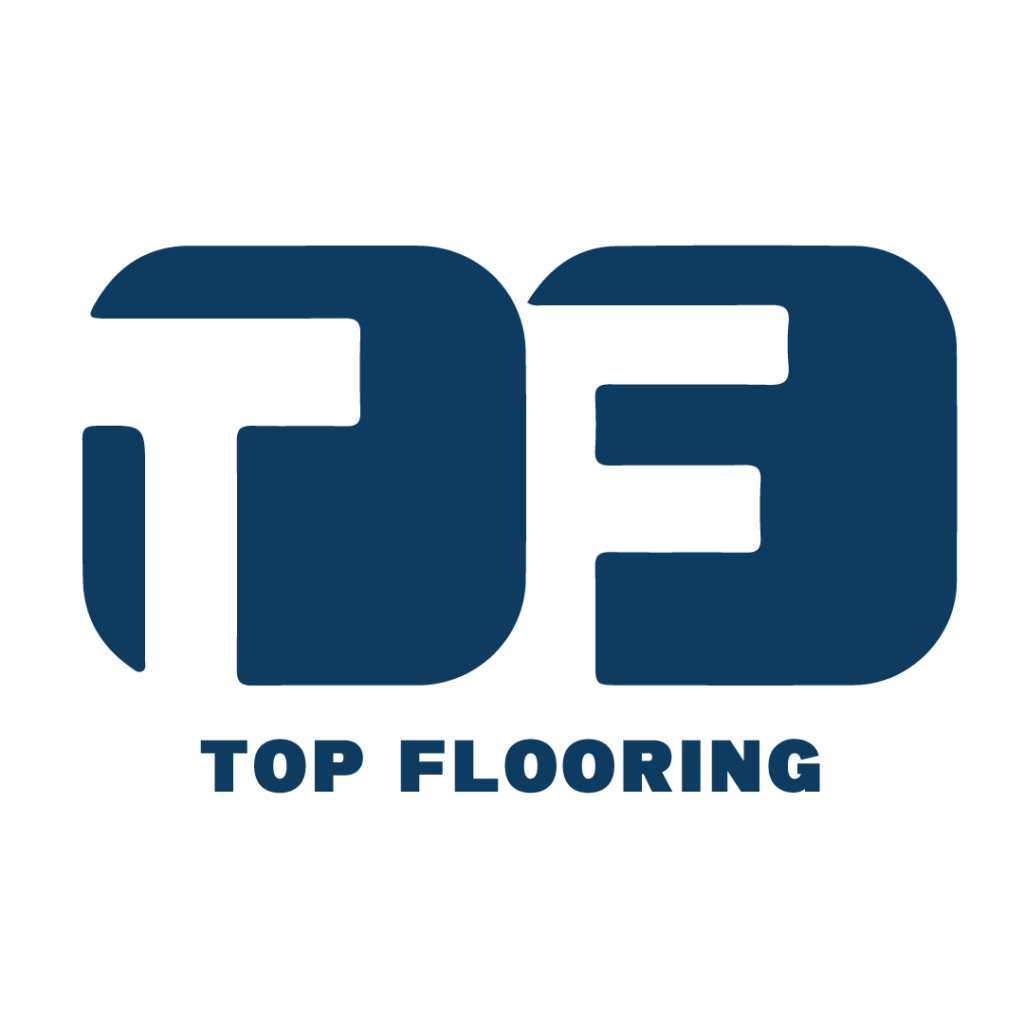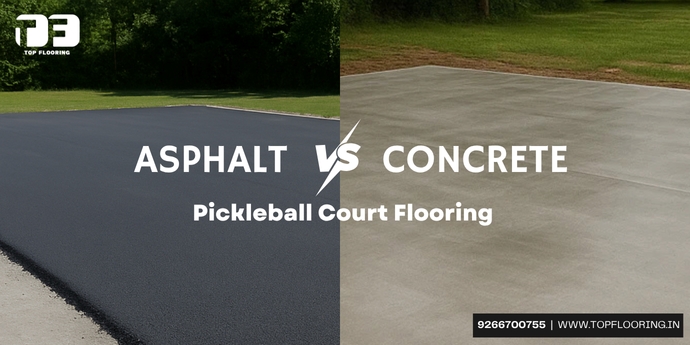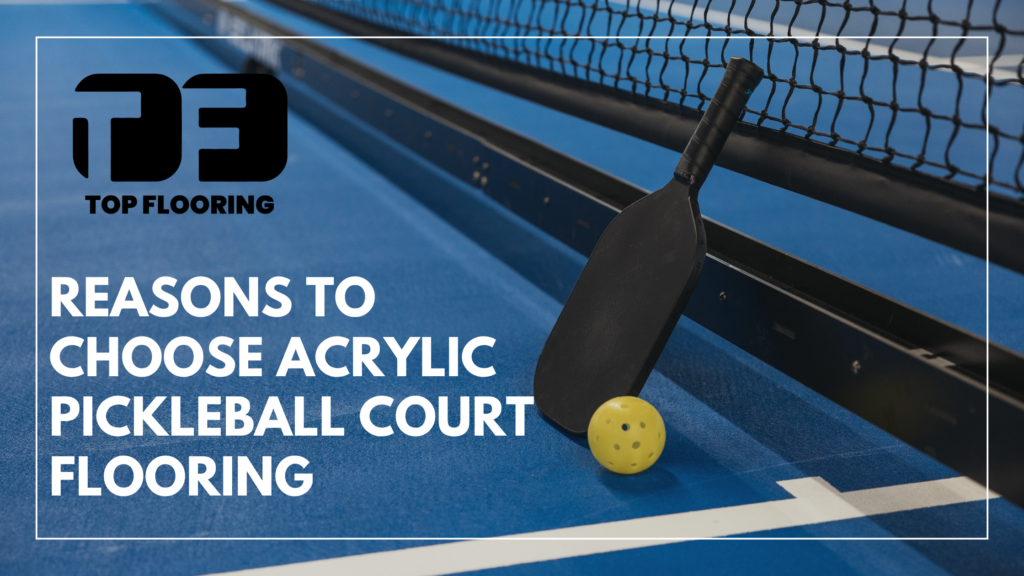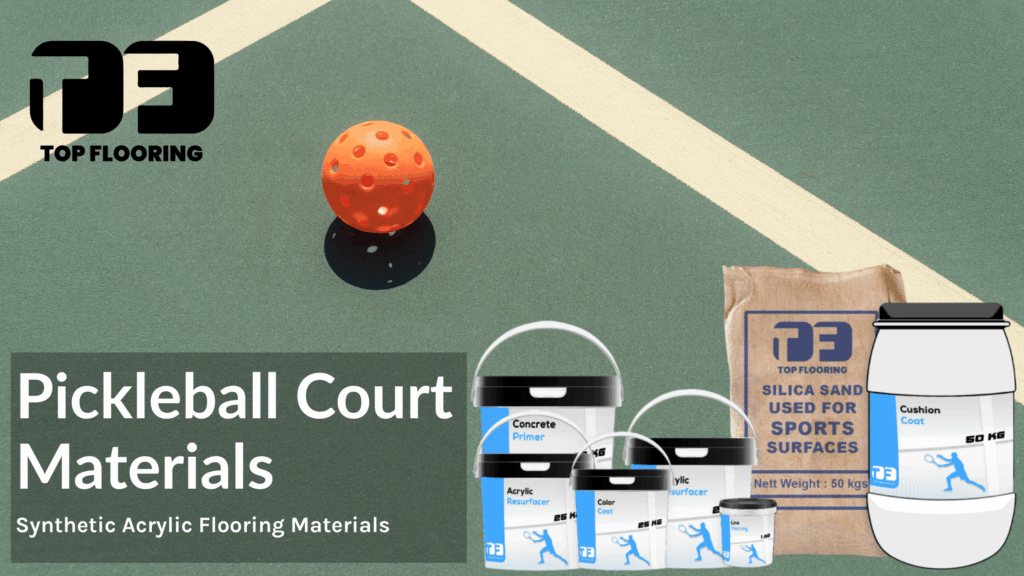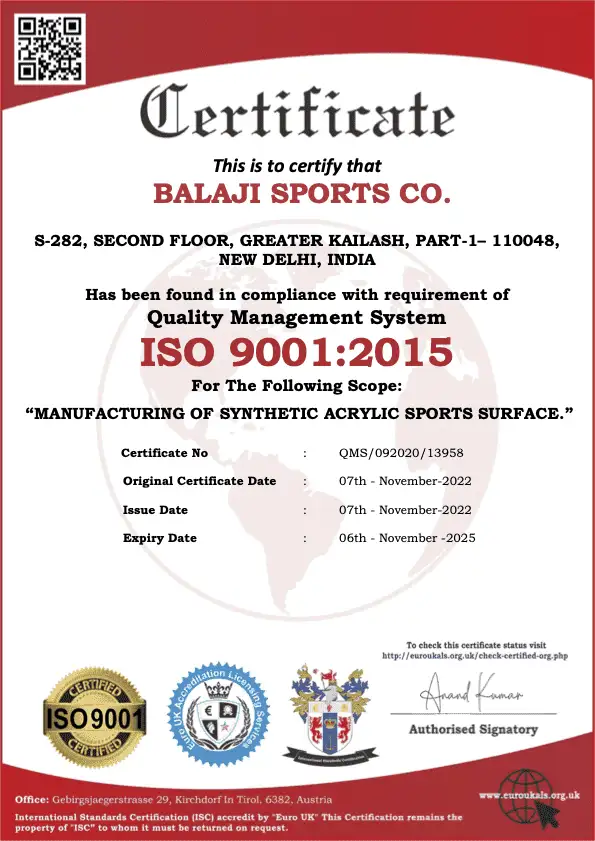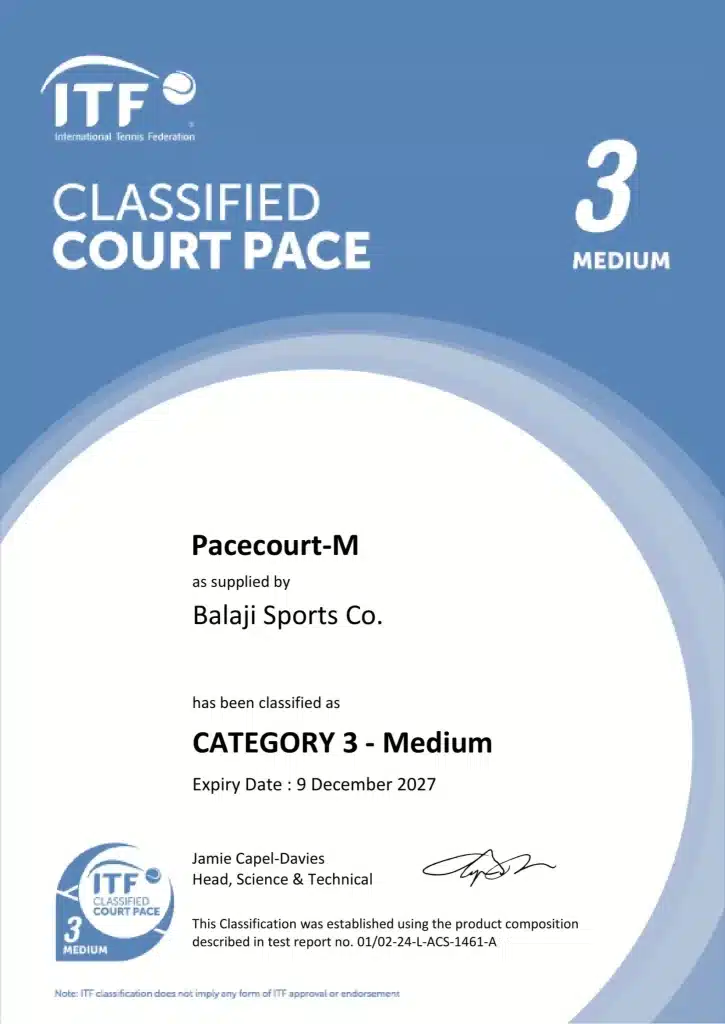Pickleball has become one of the fastest growing sports in India and is being played in residential complexes, sports academies, schools and professional clubs. The growing passion for this game has created a huge demand for high performance pickleball courts that balances comfort, durability and aesthetics. Among all the construction aspects, the base foundation of the court – whether concrete or asphalt pickleball court flooring plays the most critical role in determining the overall quality. The choice of base directly impacts bounce consistency, player safety, surface longevity and maintenance frequency especially in India’s extreme heat and heavy monsoon rainfall.
Top Flooring, a leading name in India’s synthetic acrylic sports flooring industry. It has been creating premium court surfaces for over 14 years and has delivered excellence in every project. With over 2000 courts installed across the country. And over 800 K sq. ft. of acrylic sports flooring completed. Top Flooring has become synonymous with precision, performance and reliability. Each pickleball surface system – from 5 layer to 9 layer acrylic constructions is designed to suit specific playing needs, budgets and climate. Available in 9 color options and customized shades, these systems are engineered for UV stability, all weather durability and ITF grade play quality.
By combining advanced acrylic materials with expert base engineering and slope design. Top Flooring ensures every pickleball court provides accurate bounce, superior grip and long term resilience. This blog will compare concrete vs asphalt pickleball court flooring. Evaluate the differences in cost, installation and durability and help players, societies and sports facility owners choose the base that lasts.
Understanding the Pickleball Court Base Layer
The base layer is the foundation of every pickleball court surface beneath the synthetic acrylic coating. It determines how well the court performs, drains water and withstands long term wear. A well engineered pickleball base ensures a smooth even playing surface with consistent ball bounce. Whereas a poorly prepared base can lead to surface cracks, water accumulation and uneven textures. Which compromise play quality and player safety.
In India’s climate where high heat and monsoon rains challenge outdoor courts the stability and slope of the base is critical. Any misalignment or poor drainage can shorten the life of even the best acrylic coatings. That’s why Top Flooring emphasizes proper base design, using precise gradient control (1:100 slope ratio) and advanced compaction methods to eliminate water logging and surface distortion.
Under every Top Flooring system lies a scientifically designed structure that follows international ITF-style layering standards. Whether it’s a 5 layer, 8 layer or 9 layer acrylic system, each begin with a well prepared concrete or asphalt foundation. And followed by leveling compounds, resurfacer coats and multiple acrylic layers that together create a durable high performance surface.
The result is a court that not only looks professional but also delivers true bounce, optimum grip and extended life, making every pickleball match consistent, safe and enjoyable across all seasons.
Asphalt Pickleball Court Flooring — The Popular yet Demanding Option
Asphalt pickleball court is built on a foundation made of bituminous hot-mix asphalt, a flexible material created by combining crushed stone aggregates with liquid bitumen. This mixture is compacted and rolled to form a smooth level base that serves as the structural layer beneath the synthetic acrylic sports coating. Asphalt’s natural flexibility allows it to absorb minor ground movements which makes it a commonly used base for outdoor sports courts in India.
Installation Process & Cost of Asphalt Pickleball Court
Asphalt has been a preferred base for sports flooring for a long time due to its quick installation process and cost effectiveness. In India where large residential societies and recreational complexes look for economical yet durable solutions, asphalt offers a practical advantage. The construction process involves using a hot-mix asphalt layer, compacted and rolled to achieve a smooth level surface. Since asphalt materials and machinery are widely available across the country, it becomes a faster and more accessible option compared to concrete.
On average asphalt base preparation comes in at anything from ₹60 to ₹80 per sqft – the cost before applying the acrylic system. This makes it a pretty attractive option for a budget-friendly or semi-permanent court for pickleball, especially in community parks, schools or local clubs where you’ve got tight installation timelines to get stuck into.
Performance & Playability on Asphalt Pickleball Court
An asphalt pickleball court deliver cushioning and pretty good ball response, especially right after it’s been installed. Players will find a slightly softer surface compared to rigid concrete – which can be beneficial for casual play. However the performance can vary under India’s extreme temperatures. When it is exposed to prolonged heat especially in regions where the temperature regularly tops 45°C. The asphalt base will start to soften and may begin to deform or develop surface irregularities.
This temperature sensitivity can knock both bounce consistency and surface texture off course, making it pretty vital to stick to a routine maintenance schedule. Prolonged exposure to UV rays will also cause gradual fading or hardening, reducing surface elasticity over time. Top Flooring highly recommends pairing asphalt bases with some UV-resistant acrylic coatings, like their 5-layer or 8-layer acrylic systems, to maintain stability and keep the visual appeal in check even under harsh sunlight.
Maintenance & Lifespan of Pickleball Flooring
While asphalts affordability is pretty appealing it does come with more maintenance demands over time. To prevent oxidation and cracking you’ll need to re-seal the surface every two to three years. Without getting that regular upkeep done, water seepage during the monsoons can lead to edge cracking and soft base patches, especially around drainage areas.
A well-built and properly maintained asphalt pickleball court can last 4 to 6 years but neglecting regular sealing can bring its lifespan down to as low as eight years. The maintenance frequency really does depend on local climate conditions and how effectively the drainage system was designed at the time of construction.
Best Use Case
Asphalt remains an excellent option for residential school and community pickleball courts. Where moderate play intensity and shorter project timelines are a priority. It’s going to perform best in temperate or moderately humid climates – cities like Pune, Bangalore or Hyderabad where surface temperatures won’t be too out of control.
For such installations Top Flooring’s cushioned 5-layer acrylic system adds a perfect balance of texture grip and colour retention, extending the life of asphalt bases while offering professional-grade aesthetics. With proper maintenance an asphalt pickleball court can remain a cost effective and enjoyable surface for years of regular use.
Concrete Pickleball Court Flooring — The Durable Long-Term Choice
What Is Concrete Pickleball Court Flooring?
A concrete pickleball court starts with a solid base made from a stiff cement mix-up reinforced concrete slab with some post-tension tech to stop those cracks and surface shifts in their tracks. That base forms a rock solid foundation for slapping down some synthetic acrylic paint jobs. Which gives you a professional looking surface that meets all the international play standards.
And because Indian weather can get pretty wild, especially in the hot and humid zones, a concrete base just makes a lot of sense. It’s got a nice, dense, non-flexible feel that keeps the surface rock steady, even when the temperature’s soaring or it’s chucking down rain – and it stays that way decade after decade.
Installation & Base Quality of Pickleball Court
Building a concrete base takes a bit more time and fine-tuning than just slapping down some asphalt, but the payoff is well and truly worth it. You start off by sorting out the site grading, compacting the sub-base, and chucking in some steel reinforcement before pouring the concrete in. Some of the fancier pickleball court installations use post-tensioned concrete systems – like where you stick steel cables in and then tension them up after the slab’s set, which locks the whole base together and keeps those cracks from appearing even when the ground is doing its thing.
Now I know the initial outlay is a bit steeper, typically around ₹100-₹120 per sq.ft. But this base will give you decades of stability – you can expect that surface to last for years. And remember to give it at least 28 days to cure properly before you slap on any paint. Once that’s done, you’re good to go with Top Flooring’s 8-layer or 9-layer acrylic bits, which give you top-notch adhesion and long-term performance.
Performance & Game Feel of Pickleball Flooring
A concrete court will always deliver the most consistent bounce and ball response, which makes it perfect for pro-level or tournament play. It’s rock solid, so you don’t get any of that vibration nonsense that makes the ball fly off in all directions.
Now some of you might be thinking that a concrete base can feel a bit hard on the joints, especially if you’re on the court for hours on end – but don’t worry, that’s an easy one to fix. Just chuck on a bit of cushioned acrylic paint and you’ll be golden – and you can get all that from Top Flooring’s 8-layer and 9-layer systems, which are designed to give you a smooth, comfy surface that doesn’t compromise on speed or bounce. And the finished product looks sleek, vibrant and pro – perfect for clubs, academies and all the big multi-court facilities.
Pickleball Court Maintenance & Lifespan
The great thing about a concrete base is that it’s virtually maintenance-free. Once you’ve got your surface sealed and coated, all you need to do is give it the occasional clean and maybe repaint the lines every now and again. No need to reseal it or resurface it like you would with asphalt.
A properly built concrete court will last for 7-8 years – and with an acrylic overlay, the surface will still be looking good and feeling decent in India’s mad summers and heavy monsoons. And with the right paint jobs, it’ll stay resistant to fading, cracking and water damage for years to come – so you can just play on it and forget about it.
Best Use Case
Concrete pickleball courts are best suited for commercial sports complexes, training academies, and premium residential developments that demand long-term reliability and professional-grade play. They are ideal for high-traffic environments where frequent matches or tournaments occur, and for projects where the goal is to invest once and enjoy performance for decades.
When paired with Top Flooring’s ITF-certified acrylic systems, concrete bases deliver the highest standard of surface quality — combining durability, precision, and aesthetics into a single, seamless court that performs flawlessly in every Indian climate zone.
Side-by-Side Comparison Table of Asphalt Vs Concrete Base
| Feature | Asphalt Court | Concrete Court |
| Initial Cost (Base Only) | ₹60–80/sq.ft | ₹100–120/sq.ft |
| Installation Time | 3–5 days | 7–10 days |
| Lifespan | 10–15 years | 25–30 years |
| Maintenance | High (reseal every 2–3 yrs) | Low (minor repainting) |
| Heat Resistance | Poor above 45°C | Excellent |
| Crack Resistance | Moderate | High (post-tension systems) |
| Player Comfort | Softer | Harder, needs cushion coat |
| Best For | Budget or residential courts | Long-term commercial projects |
Climate Impact: India’s Weather and Surface Choice
India’s wide ranging climate – from blistering summers to the heavy monsoons and the humid coastlines – all have a profound effect on how well a pickleball court base holds up. Choosing the right base is crucial to get a base that will last the long haul, be stable on the surface and just generally play smoothly.
In those super hot areas like Rajasthan and Delhi NCR where the temperatures just soar above 45 celsius, asphalt bases go soft and start to lose shape causing all sorts of bumps and ridges on the surface. But concrete, on the other hand, stays solid as a rock and doesn’t even flinch in the face of all that sun beating down on it. Then there are coastal regions like Kerala, Chennai or Goa where the air is always moist and salty, which is why concrete performs so much better – it resists corrosion and helps stop surface erosion.
In hill regions where it’s not too cold, in places like Shimla, Ooty or Mussoorie, asphalt has an advantage because it’s a bit more flexible and can cope with the occasional thermal expansion and contraction. And then there are regions that are basically just one big monsoon where water doesn’t just come and go, it stays put. In those cases drainage design becomes super important, so both bases need a gentle slope of about 1 to 100 and a special waterproof seal on top to stop the water from pooling and the surface from cracking.
Every single Acrylic Top Flooring system – whether its the 5 layer or the 9 layer – comes with special UV-stable and water resistant coatings that help both asphalt and concrete bases do their job in India’s tough weather conditions.
The Role of Acrylic Surfacing on Both Bases
Whether someone’s building a pickleball court on asphalt or concrete, it’s the acrylic surfacing system that really makes the difference in performance, colour and how comfortable it is to play on. The acrylic coating acts like a protective shield, sealing the base, reducing friction, and keeping it safe from UV rays, the rain and extreme temperature swings. It also gives you that textured finish that’s essential for a controlled grip, a consistent bounce and long-lasting colour.
Helping to make the court a lot more comfortable for players are the cushied acrylic layers. On hard concrete bases, they add some much-needed flexibility and impact absorption, making the court a lot easier on the joints without affecting the way the ball bounces. And on asphalt bases, the acrylic coating keeps the surface stable and stops it from softening up in hot weather or oxidizing.
Top Flooring’s top-of-the-line ITF-approved systems – available in 5 layer, 8 layer and 9 layer configurations – will work just as well on either base type. The 5 layer is best for recreational play while the 8 and 9 layer cushioned versions will deliver professional grade performance and a lot more comfort. This multi layered coating can turn just about any solid base into a durable, vibrant and high performing pickleball court that can handle even the worst of India’s weather conditions.
Cost Analysis: Short-Term vs Long-Term ROI
When someone is planning a pickleball court, the choice between asphalt and concrete usually comes down to how much you have in your budget for pickleball court versus the long term benefits. While an asphalt base might be a lot cheaper in the short term, its higher maintenance costs makes concrete the better long term investment.
Asphalt ROI
A concrete court demands a hefty upfront investment, but their maintenance needs are a lot lower, making them cost effective over the years. With a lifespan that exceeds two decades and minimal resurfacing needed, the total 10 year cost is typically between ₹250-₹300 per sq.ft. The concrete courts have better structural integrity, a more consistent bounce and better resistance to the weather, which reduces long term expenses.
Concrete ROI
Concrete courts demand a higher upfront investment, but their low maintenance needs make them more cost-efficient over the years. With a lifespan exceeding two decades and minimal resurfacing, the total 10-year cost typically falls between ₹250–₹300 per sq.ft. Concrete courts deliver stronger structural integrity, consistent bounce, and better weather resistance, reducing long-term expenses.
Insight: Although asphalt is the cheaper option in the short term, concrete pays for itself within 5-6 years, offering a much better return on investment (ROI) and sustained performance for professional and high traffic pickleball facilities.
Common Mistakes in Base Selection
Even the best acrylic coating can’t compensate for a bad base. Several pickleball court construction errors can reduce the performance and lifespan of pickleball courts in India. One of the most common mistakes is ignoring soil compaction and drainage planning. A weak or uneven sub-base allows water to collect beneath the surface and causes cracks and surface undulation. Another major oversight is using asphalt in very hot regions, where surface temperatures above 45°C can soften and deform. Builders also sometimes skip slope correction—the required 1:100 gradient—which is essential for smooth water runoff during monsoons.
Applying acrylic coatings before the base fully cures traps moisture, which later causes bubbles or peeling. And using low grade or inconsistent base materials, especially in small private projects, can compromise long term strength. Top Flooring’s technical team follows ITF construction standards to eliminate these errors. And ensure every court base is engineered for precision, durability, and all-weather play.
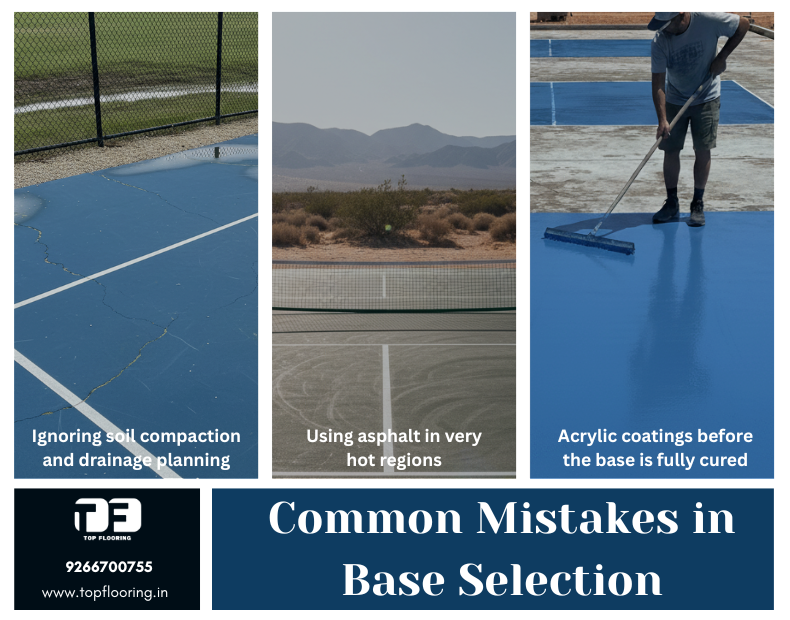
Which Base Should You Choose For Pickleball Court?
Selecting between asphalt and concrete ultimately depends on budget, usage intensity, and long-term goals. Both materials can perform exceptionally well when paired with the right Top Flooring acrylic surfacing system, but each has its ideal application. For residential societies, schools, and small community courts, asphalt is a practical and cost-efficient option. When resurfaced regularly and sealed with a UV-stable 5-layer acrylic coating, it offers good playability and appealing aesthetics within a moderate budget.
For sports clubs, academies, and government projects, concrete remains the superior choice. Its stability, long lifespan, and low maintenance deliver unmatched return on investment over time. The 8-layer or 9-layer cushioned acrylic systems from Top Flooring further enhance comfort and professional-level performance. In multi-court complexes or commercial sports facilities, concrete ensures uniform leveling, structural reliability, and consistent bounce across all courts.
For home or private setups, pairing asphalt with high-quality acrylic surfacing offers a smart, affordable option — provided the slope and drainage are properly maintained.
Why Choose Top Flooring?
Choosing the right partner for your pickleball court construction makes all the difference between a surface that lasts a few seasons and one that performs for decades. Top Flooring is one of India’s most trusted names in synthetic acrylic sports flooring, known for precision engineering, premium materials and climate adaptive design. We offers unmatched reliability and finish quality. Every project—whether for residential societies, clubs, schools, or large sports complexes—is built using ITF-approved and ISO-certified acrylic systems engineered to withstand India’s heat, humidity, and heavy rainfall.
Top Flooring offers 5 layer, 8 layer and 9 layer acrylic systems in 9 color options, customizable for cushion, texture and gloss. Each layer deliver UV resistance, superior grip, and consistent ball response. So you get professional level playability on every surface. Top Flooring combines technical excellence with aesthetic design, making every court a lasting investment in performance and durability.
Conclusion
The quality of your pickleball court’s base work has a huge impact on how long it lasts, how well it plays and whether it’s genuinely safe to be on. Both asphalt & concrete have their own strengths & weaknesses: asphalt gets you a fast installation deal that’s just right for casual or home courts, while concrete gives you sturdy structure, low upkeep and long-term value for clubs, schools & businesses.
No matter what base material you choose, it’s the acrylic coating system that makes it into a pro sports surface. Do it right with accuracy to achieve a court that offers smooth, consistent bounce, UV protection, and a slip-proof finish all year round.
For tailored recommendations, design support, or project-specific estimates, consult the experts at Top Flooring. With more than 14 years of experience and hundreds of successful installations nationwide, the team delivers ITF-standard synthetic acrylic courts built for Indian conditions and lasting performance.
Frequently Asked Questions
Concrete base lasts for 10–15 years, nearly double asphalt’s lifespan.
Yes, asphalt is cheaper. But maintenance costs can exceed concrete’s over time.
Yes asphalt softens beyond 45°C, leading to deformation and cracks.
Absolutely. Both bases can be finished with Top Flooring’s ITF-grade acrylic systems.
